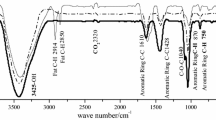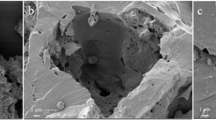Abstract
Persistent organic pollutants (POPs) immobilization in farm land is an important issue to solve the residue in crop, and char has been considered for the remediation. In here, three commercially available chars like powdered oak char (POC), granulated oak char (GOC), and rice husk char (RHC) including powdered activated carbon (PAC) were investigated for their potential to adsorb and immobilize endosulfan in the soil. The maximum adsorption capacities (mg g−1) of the applied chars as POC, GOC, and RHC were 714.8, 322.6, and 181.8, respectively, and the capacity of POC was similar with PAC (713.8). In addition, the pore volume (0.138 cm3 g−1) and the surface area (270.3 m2 g−1) of POC were over 3-fold higher than GOC and RHC. The bioconcentration factor (BCF) reducing effect of α-, β-endosulfan, and endosulfan sulfate in oriental radish (Raphanus sativus var. sativus) was investigated by amendment of three commercially available chars to the contaminated soils. The BCF of total endosulfan was 0.025 in the radish root. POC treatments effectively suppressed the endosulfan uptake (BCF 0.002). However, GOC and RHC showed little BCF reducing effect of endosulfan in radish.
Similar content being viewed by others
References
Ahmad, M., Lee, S. S., Dou, X. M., Mohan, D., Sung, J. K., Yang, J. E., & Ok, Y. S. (2012). Effects of pyrolysis temperature on soybean stover—and peanut shell—derived biochar properties and TCE adsorption in water. Bioresource Technology, 118, 536–544.
Beesley, L., Moreno-Jiménez, E., Gomez-Eyles, J. L., Harris, E., Robinson, B., & Sizmur, T. (2011). A review of biochars’ potential role in the remediation, revegetation and restoration of contaminated soils. Environmental Pollution, 159, 3269–3282.
Chun, Y., Sheng, G., Chiou, C. T., & Xing, B. (2004). Compositions and sorptive properties of crop residue-derived chars. Environmental Science & Technology, 38, 4649–4655.
Damalas, C. A., & Eleftherohorinos, I. G. (2011). Pesticide exposure, safety issues, and risk assessment indicators. International Journal of Environmental Research and Public Health, 8, 1402–1419.
Devi, N. L., Yadav, I. C., Raha, P., Shihua, Q., & Dan, Y. (2015). Spatial distribution, source apportionment and ecological risk assessment of residual organochlorine pesticides (OCPs) in the Himalayas. Environmental Science and Pollution Research, 22, 20154–20166.
Do, Y. S., Kim, J. B., Kang, S. H., Kim, N. Y., Eom, M. N., & Yoon, M. H. (2013). Probabilistic exposure assessment of pesticide residues in agricultural products in Gyeonggi-do. The Korean Journal of Pesticide Science, 17(2), 117–125.
Hwang, J. I., Kwak, S. Y., Lee, S. Y., Kang, M. S., Ryu, J. S., Kang, J. G., Jung, H. H., Hong, S. H., & Kim, J. E. (2016). Establishment of safe management guideline based on uptake pattern of pesticide residue from soil by radish. Korean Journal of Environmental Agriculture, 35(4), 278–285.
Jeon, W. T., Seong, K. Y., Lee, J. K., Oh, I. S., Lee, Y. H., & Ok, Y. S. (2010). Effects of green manure and carbonized rice husk on soil properties and rice growth. Korean Journal of Soil Science and Fertilizer, 43(4), 484–489.
Jones, D. L., Edwards-Jones, G., & Murphy, D. V. (2011). Biochar mediated alterations in herbicide breakdown and leaching in soil. Soil Biology & Biochemistry, 43, 804–813.
Khan, S., Waqas, M., Ding, F., Shamshad, I., Arp, H. P. H., & Li, G. (2015). The influence of various biochars on the bioaccessibility and bioaccumulation of PAHs and potentially toxic elements to turnips (Brassica rapa L.) Journal of Hazardous Materials, 300, 243–253.
Khorram, M. S., Zhang, Q., Lin, D., Zheng, Y., Fang, H., & Yu, Y. (2016). Biochar: a review of its impact on pesticide behavior in soil environments and its potential applications. Journal of Environmental Sciences, 44, 269–279.
Kim, J. H., & Smith, A. (2001). Distribution of organochlorine pesticides in soils from South Korea. Chemosphere, 43, 137–140.
Kim, Y. S., Eun, H., Cho, H. S., Kim, K. S., Sakamoto, T., Watanabe, E., Baba, K., & Katase, T. (2008). Organochlorine pesticides in the sediment core of Gwangyang bay, South Korea. Archives of Environmental Contamination and Toxicology, 54, 386–394.
Lozowicka, B., Kaczynski, P., Wolejko, E., Piekutin, J., Sagitov, A., Toleubayev, K., Isenova, G., & Abzeitova, E. (2016). Evaluation of organochlorine pesticide residues in soil and plants from East Europe and Central Asia. Desalination and Water Treatment, 57, 1310–1321.
Martin, S. M., Kookana, R. S., Zwieten, V. L., & Krull, E. (2012). Marked changes in herbicide sorption-desorption upon ageing of biochars in soil. Journal of Hazardous Materials, 231-232, 70–78.
Mishra, P. C., & Patel, R. K. (2008). Removal of endosulfan by sal wood charcoal. Journal of Hazardous Materials, 152, 730–736.
Mitton, F. M., Gonzalez, M., Monserrat, J. M., & Miglioranza, K. S. B. (2016). Potential use of edible crops in the phytoremediation of endosulfan residues in soil. Chemosphere, 148, 300–306.
Odukkathil, G., & Vasudevan, N. (2016). Residues of endosulfan in surface and subsurface agricultural soil and its bioremediation. Journal of Environmental Management, 165, 72–80.
Park, H. J., Choi, J. H., Park, B. J., Kim, C. S., Ihm, Y. B., & Ryu, G. H. (2004). Uptake of endosulfan and procymidone from arable soil by several vegetables I (green house study). The Korean Journal of Pesticide Science, 8(4), 280–287.
Park, J. H., Cho, J. S., Ok, Y. S., Kim, S. H., Heo, J. S., Delaune, R. D., & Seo, D. C. (2016). Comparison of single and competitive metal adsorption by pepper stem biochar. Journal of Archives of Agronomy and Soil Science, 62, 617–632.
Rao, D. M. R., & Murty, A. S. (1980). Persistence of endosulfan in soils. Journal of Agricultural and Food Chemistry, 28, 1099–1101.
Shivaramaiah, H. M., Sanchez-Bayo, F., Al-Rifai, J., & Kennedy, I. R. (2005). The fate of endosulfan in water. Journal of Environmental Science and Health-Part B, 40, 711–720.
Singh, V., & Singh, N. (2014). Uptake and accumulation of endosulfan isomers and its metabolite endosulfan sulfate in naturally growing plants of contaminated area. Ecotoxicology and Environmental Safety, 104, 189–193.
Sohi, S. P., Krull, E., Lopez-Capel, E., & Bol, R. (2010). Chapter 2—a review of biochar and its use and function in soil. Advances in Agronomy, 105, 47–82.
UNEP (2009). The POPs; all POPs listed in the Stockholm Convention. Stochkholm convention, United Nations Environment Programme (UNEP). http://chm.pops.int/TheConvention/ThePOPs/AllPOPs/tabid/2509/Default.aspx. Accessed 27 July 2017.
Yang, X. B., Ying, G. G., Peng, P. A., Wang, L., Zhao, J. L., Zhang, L. J., Yuan, P., & He, H. P. (2010). Influence of biochars on plant uptake and dissipation of two pesticides in an agricultural soil. Journal of Agriculutrual and Food Chemistry, 58, 7915–7921.
Yedla, S., & Dikshit, A. K. (2001). Removal mechanism of endosulfan sorption onto wood charcoal. International Journal of Environment and Pollution, 15(5), 528–542.
Yu, X. Y., Mu, C. L., Gu, C., Liu, C., & Liu, X. J. (2011). Impact of woodchip biochar amendment on the sorption and dissipation of pesticide acetamiprid in agricultural soils. Chemosphere, 85, 1284–1289.
Acknowledgements
This work was supported by a grant from “Research Program for Agricultural Science & Technology Development,” National Academy of Agricultural Science, Rural Development Administration (Project No. PJ011435), Republic of Korea.
Author information
Authors and Affiliations
Corresponding author
Electronic Supplementary Material
ESM 1
(DOCX 388 kb)
Rights and permissions
About this article
Cite this article
Choi, GH., Lee, DY., Seo, DC. et al. Endosulfan Plant Uptake Suppression Effect on Char Amendment in Oriental Radish. Water Air Soil Pollut 229, 24 (2018). https://doi.org/10.1007/s11270-017-3677-x
Received:
Accepted:
Published:
DOI: https://doi.org/10.1007/s11270-017-3677-x




